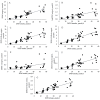Urinary and Serum Concentration of Deoxynivalenol (DON) and DON Metabolites as an Indicator of DON Contamination in Swine Diets
- PMID: 36828434
- PMCID: PMC9967145
- DOI: 10.3390/toxins15020120
Urinary and Serum Concentration of Deoxynivalenol (DON) and DON Metabolites as an Indicator of DON Contamination in Swine Diets
Abstract
Pig health is impaired and growth performance is reduced when exposed to deoxynivalenol (DON). The measurement of DON in individual feedstuffs and complete swine diets is variable because of the inconsistent distribution of mycotoxins in feed and the difficulties in obtaining representative samples. We investigated whether measuring DON and its metabolites in biological samples could be used as a predictor of DON ingestion by pigs. Blood samples were collected between 3 and 4 h after the morning meal and urine samples were quantitatively collected over a 24 h period on d 40 and 82 of the study to evaluate serum and urinary content of DON and DON metabolites (iso-deoxynivalenol, DON-3-glucuronide, DON-15-glcurunide, deepoxy-deoxynivalenol, iso-deepoxy-deoxynivalenol, deepoxy-deoxynivalenol-3-glucuronide, and deepoxy-deoxynivalenol-15-glucuronide). The intake of DON was positively correlated with urinary DON output. Similarly, there was an increase in serum DON level with increasing DON intake. Overall, it was found that DON intake correlated with DON concentration in urine and blood serum when samples were collected under controlled conditions. Analyzing DON levels in urine and blood serum could be used to predict a pig's DON intake.
Keywords: DOM; biomarkers; deoxynivalenol; iso-DON; metabolites; serum; urine.
Conflict of interest statement
V.N. is an employee of Biomin Holding GmbH. All other authors declare no conflict of interest.
Figures


References
-
- Wellington M.O., Bosompem M.A., Petracek R., Nagl V., Columbus D.A. Effect of Long-Term Feeding of Graded Levels of Deoxynivalenol (DON) on Growth Performance, Nutrient Utilization, and Organ Health in Finishing Pigs and DON Content in Biological Samples. J. Anim. Sci. 2020;98:skaa378. doi: 10.1093/jas/skaa378. - DOI - PMC - PubMed
-
- Pestka J.J. Deoxynivalenol: Toxicity, Mechanisms and Animal Health Risks. Anim. Feed Sci. Technol. 2007;137:283–298. doi: 10.1016/j.anifeedsci.2007.06.006. - DOI
Publication types
MeSH terms
Substances
LinkOut - more resources
Full Text Sources

